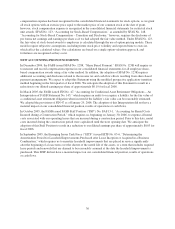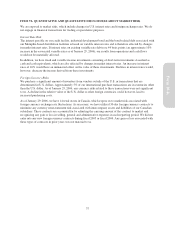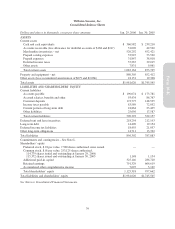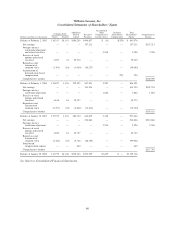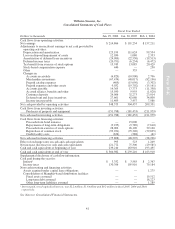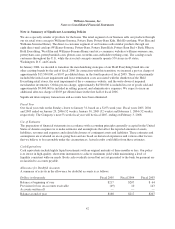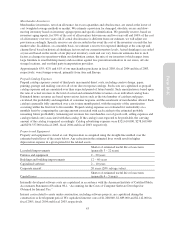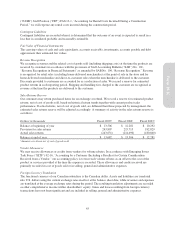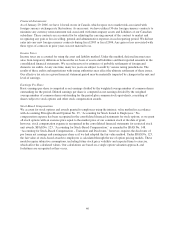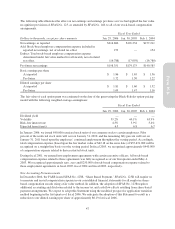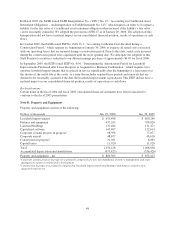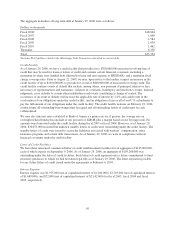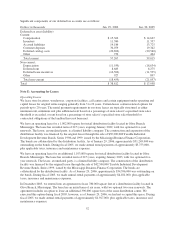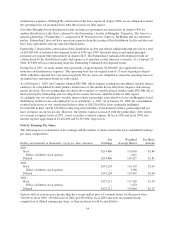Pottery Barn 2005 Annual Report Download - page 56
Download and view the complete annual report
Please find page 56 of the 2005 Pottery Barn annual report below. You can navigate through the pages in the report by either clicking on the pages listed below, or by using the keyword search tool below to find specific information within the annual report.For any store closures where a lease obligation still exists, we record the estimated future liability associated with
the rental obligation on the date the store is closed in accordance with Statement of Financial Accounting
Standards (“SFAS”) No. 146, “Accounting for Costs Associated with Exit or Disposal Activities.” However,
most store closures occur upon the lease expiration.
We review the carrying value of all long-lived assets for impairment whenever events or changes in
circumstances indicate that the carrying value of an asset may not be recoverable. In accordance with SFAS
No. 144, “Accounting for the Impairment or Disposal of Long-Lived Assets,” we review for impairment all
stores for which current cash flows from operations are negative, or the construction costs are significantly in
excess of the amount originally expected. Impairment results when the carrying value of the assets exceeds the
undiscounted future cash flows over the life of the lease. Our estimate of undiscounted future cash flows over the
lease term (typically 5 to 22 years) is based upon our experience, historical operations of the stores and estimates
of future store profitability and economic conditions. The future estimates of store profitability and economic
conditions require estimating such factors as sales growth, employment rates, lease escalations, inflation on
operating expenses and the overall economics of the retail industry for up to 20 years in the future, and are
therefore subject to variability and difficult to predict. If a long-lived asset is found to be impaired, the amount
recognized for impairment is equal to the difference between the carrying value and the asset’s fair value. The
fair value is estimated based upon future cash flows (discounted at a rate that approximates our weighted average
cost of capital) or other reasonable estimates of fair market value.
Lease Rights and Other Intangible Assets
Lease rights, representing costs incurred to acquire the lease of a specific commercial property, are recorded at
cost in other assets and are amortized over the lives of the respective leases. Other intangible assets include fees
associated with the acquisition of our credit facility and are recorded at cost in other assets and amortized over
the life of the facility.
Self-Insured Liabilities
We are primarily self-insured for workers’ compensation, employee health benefits and product and general
liability claims. We record self-insurance liabilities based on claims filed, including the development of those
claims, and an estimate of claims incurred but not yet reported. Factors affecting this estimate include future
inflation rates, changes in severity, benefit level changes, medical costs and claim settlement patterns. Should a
different amount of claims occur compared to what was estimated, or costs of the claims increase or decrease
beyond what was anticipated, reserves may need to be adjusted accordingly. We determine our workers’
compensation liability and general liability claims reserves based on an actuarial analysis. Reserves for self-
insurance liabilities are recorded within accrued salaries, benefits and other on our consolidated balance sheet.
Customer Deposits
Customer deposits are primarily comprised of unredeemed gift certificates and merchandise credits and deferred
revenue related to undelivered merchandise. We maintain a liability for unredeemed gift certificates and
merchandise credits until the earlier of redemption, escheatment or seven years. After seven years, the remaining
unredeemed gift certificate or merchandise credit liability is relieved and recorded within selling, general and
administrative expenses.
Deferred Rent and Lease Incentives
For leases that contain fixed escalations of the minimum annual lease payment during the original term of the
lease, we recognize rental expense on a straight-line basis over the lease term, including the construction period,
and record the difference between rent expense and the amount currently payable as deferred rent. Any rental
expense incurred during the construction period is capitalized as a leasehold improvement within property and
equipment and depreciated over the lease term. Deferred lease incentives include construction allowances
received from landlords, which are amortized on a straight-line basis over the lease term, including the
construction period. Beginning in fiscal 2006, in accordance with Financial Accounting Standards Board
44




